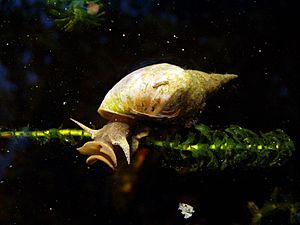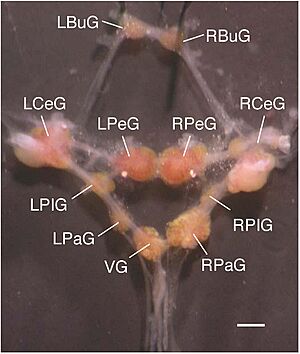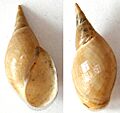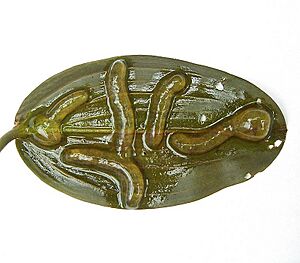Great pond snail facts for kids
Quick facts for kids Great pond snailLymnaea stagnalis |
|
|---|---|
 |
|
| Conservation status | |
| Scientific classification |
The great pond snail (Lymnaea stagnalis) is a large freshwater snail. It breathes air and lives in water. This snail is a type of gastropod mollusk from the Lymnaeidae family. Scientists often study the great pond snail. They use it to learn about how parasites work, how brains function, how animals develop, and how genes are controlled.
Contents
Where the Great Pond Snail Lives
You can find the great pond snail in many parts of the world. It lives mainly in the cooler areas of North America, Europe, and Asia. These snails like ponds, lakes, and slow-moving rivers. They prefer places with lots of plants underwater.
You can find them far north in Norway. In Central Europe, they even live in mountains up to 1,700 meters (about 5,600 feet) high. In some places, scientists use these snails to check how clean the water is. If you find them, it often means the water is quite healthy.
The Snail's Shell
The shell of the great pond snail can be light brown to dark brown. Adult shells are usually 45 to 60 millimeters (about 1.8 to 2.4 inches) tall. Sometimes, you might find a very large one, up to 70 millimeters (2.8 inches) tall! The shell is usually 20 to 30 millimeters (0.8 to 1.2 inches) wide.
The shell has about 4 to 6 spirals, called whorls. The top part of the shell is pointy. The last spiral is much wider and looks a bit puffed up. Young great pond snails can sometimes look like other snails, like those from the Physa group. But adult great pond snails are much bigger than most other similar snails.
The Snail's Nervous System

LBuG and RBuG: left and right buccal ganglia
LCeG and RCeG: left and right cerebral ganglia
LPeG and RPeG: left and right pedal ganglia
LPIG and RPIG: left and right pleural ganglia
LPaG and RPaG: left and right parietal ganglia
VG: visceral ganglion.
Scientists often study the great pond snail to learn about learning and memory. They also study its nervous system. This snail has a fairly simple central nervous system. It has about 20,000 nerve cells, called neurons. Many of these neurons are large. This makes them easy for scientists to study.
By studying these snails, researchers have learned a lot. They have found out how nerve cells work together to control simple actions. These actions include eating, breathing, and moving. They have also learned about how nerve cells repair themselves. The snail helps us understand how we learn and form memories.
Life Cycle of the Great Pond Snail
The great pond snail is a hermaphrodite. This means that each snail has both male and female reproductive parts. This allows them to lay eggs after mating with another snail.
Parasites of the Great Pond Snail
The great pond snail can be a home for different parasites. It acts as an intermediate host for some of them. This means the parasite lives part of its life inside the snail before moving to another animal.
Some parasites that can live in the great pond snail include:
- Moliniella anceps
- Echinoparyphium aconiatum
- Echinoparyphium recurvatum
- Echinostoma revolutum
Keeping Great Pond Snails as Pets
You can easily keep great pond snails in a freshwater aquarium. They do well at room temperature. You can feed them different vegetables like salad, cabbage, and dandelion leaves. They will also eat fish food. These snails can even help clean your aquarium by eating algae. They might also eat small pests like the Hydra viridissima polyp or the eggs of other water snails.
It is important to keep the water clean. Remove any leftover food quickly. You should also change the water often. Using a water conditioner can help. Snails need calcium for their shells. You can give them a piece of cuttlebone to help them get enough calcium, especially if your water is soft.





